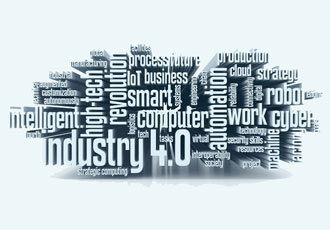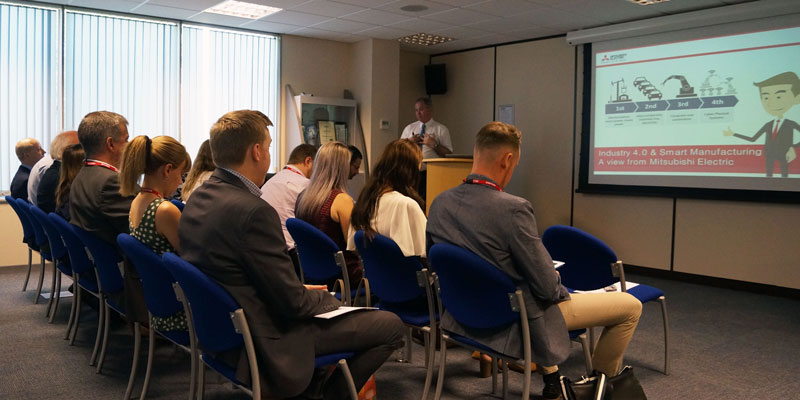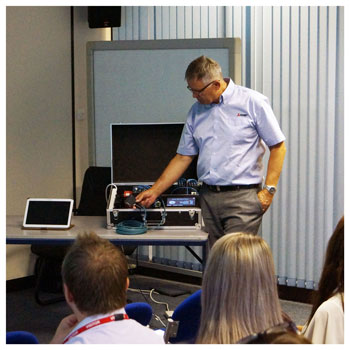Mitsubishi is on the road to digitalisation

Let’s take a minute to picture a world where everything connects, an Industry 4.0 utopia, all parts are interlinked and co-exist with each other. This is what the main aim and vision of Industry 4.0 is, companies should be trying to achieve this throughout and eventually the whole industry would be able to connect together.
It is straight forward, all parts of an operation are interlinked and coexist, with efficiencies, cost reductions and productivity increases achieved through integrated automation. That sounds good but what does that really mean and how do we start along the road to implementing the goals of Industry 4.0 and the smart factory?
Engineering Specifier editor Anna recently attended Mitsubishi Electric’s press day focussing on digitalisation and the future of Industry 4.0, at which the company explained in the future there will be a benchmark for digitalisation, whereas at the moment it is still just a concept. So how do we achieve this?

Mitsubishi Electric has taken it upon itself to tackle these questions and highlight how the company are working hard to make this paradise a reality. Building on over 35 years’ experience of automating factories in the UK and by embracing the smart factory and Industry 4.0 concepts, Mitsubishi has distilled that guidance into a whitepaper entitled ‘Industry 4.0 – The road to digitalisation in future manufacturing'.
Mitsubishi Electric Marketing and Operations Group Manager Chris Evans said: “There is so much terminology batted around when we start to consider Industry 4.0 that it can lead to a cloud of confusion. On one level we are looking at the convergence of business systems with the physical plant control but is this really new? Does this really move us on from where we are today? The real impetus behind Industry 4.0 comes not just from the link between the plant and the enterprise but once we have this link, not only can we have the means to improve performance but also to measure actual performance against an ideal model – the cyber physical system if you will.”
It is this ability for in-depth analysis and continuous improvement that Evans said defines the true spirit of Industry 4.0 - but how do we get there?
Are the UK’s manufacturing plants ready to be smart factories?
“If we built a brand new plant from the ground up on a greenfield site, we could build a smart factory that would embody all the goals of Industry 4.0, all using technologies that are readily available today,” he commented. “However the challenge with many manufacturing plants is that their automation systems have evolved over many years, resulting in disparate automation platforms, poor network infrastructure, no data management strategy and very little genuine knowledge of how to get the relevant information out.”
So how does a manufacturer start out on the road to digitalisation?
Setting out standards will help initially in moving forward.
According to Evans, it’s all about the planning. “You have to define exactly what it is the manufacturer is trying to achieve, what are their business drivers and you have to understand where their problem areas are. You have to look at what automation currently exists and what automation network infrastructure is already in place, if any. You have to accept that it’s going to take time – perhaps a number of years – and it’s going to take investment. The key is to look for the quick wins that will demonstrate fast returns against a moderate budget and which prove that the path you’re taking will deliver much bigger benefits over the longer term.” He goes on, “understanding what is happening at the production plant is essential and an infrastructure must be created to achieve this, even if this is approached in stages, whilst always keeping an eye on the end goal. If you don’t know what’s going on, you don’t know what’s going wrong.”
Highlighting what can be achieved, Mitsubishi Electric has undertaken smart factory implementations at its own manufacturing facilities. As an example, at its Kani Works switchgear production facility, a smart factory upgrade drove a significant increase in productivity and operating rate and a large reduction in the number of stages in the manufacturing process. By redesigning the production line into a more compact manufacturing cell, utilising robotics and vision as well as conventional automation control, huge savings were made in the occupied floor space – some 85% reduction – and this is particularly significant, as in the majority of manufacturing plants space is at a premium.
This was all achieved using Mitsubishi Electric’s own automation technologies and utilising complementary technologies from its e-F@ctory Alliance partners.
Kani Works is a true example of a smart factory embracing the principles of Industry 4.0 and utilising cyber physical modelling to achieve continuous improvement.
The company also highlighted the importance of planning to be smart and went into further detail about it being most important to understand what you are trying to achieve. A good way of starting this is identifying where the problem areas are, what automation already exists and additionally what network infrastructure exists.
From there developing a strategic plan with a staged approach but keeping the focus on the final goal is the route to success with Industry 4.0. However, for this to run smoothly it is crucial that the company can manage expectations and agree on time scales, this is what can lead you to quick wins.
In its whitepaper, ‘Industry 4.0 – The road to digitalisation in future manufacturing’, Mitsubishi Electric defines the basis of Industry 4.0 and the overlapping principles of interoperability, information, integration, automation and autonomy. It defines the key features of Industry 4.0, looking at the importance of areas such as communications, cyber physical systems, cyber security, new computing models such as edge computing and cloud computing and standards such as OPC UA and the forthcoming RAMI4.0 and IIRA architecture models.
The whitepaper then lays out the key steps on the road to digitalisation, concluding that, while there are undoubtedly challenges to be overcome, it is quite possible to convert an ageing plant into a smart factory using today’s technologies through correct planning and by taking a structured approach.
“Most plants in the UK haven’t had the luxury of being designed from scratch to meet the goals of Industry 4.0 but that doesn’t mean it can’t be done,” concluded Evans. “With strategic planning and a structured approach, any plant can reap the benefits of optimised, sustainable, safe production that is energy efficient, all within a fully connected supply chain. The road to digitalisation begins with the first step.”
To download the whitepaper click here.
Similar articles
More from Mitsubishi
- Want a robot but don’t know where to start? 11th June 2021
- A pizza challenge for Control Freaks 22nd April 2021
- Competitive factories need to leverage the power of data 15th April 2021
- Combining user-friendliness with high performance 16th March 2021












Write a comment
No comments